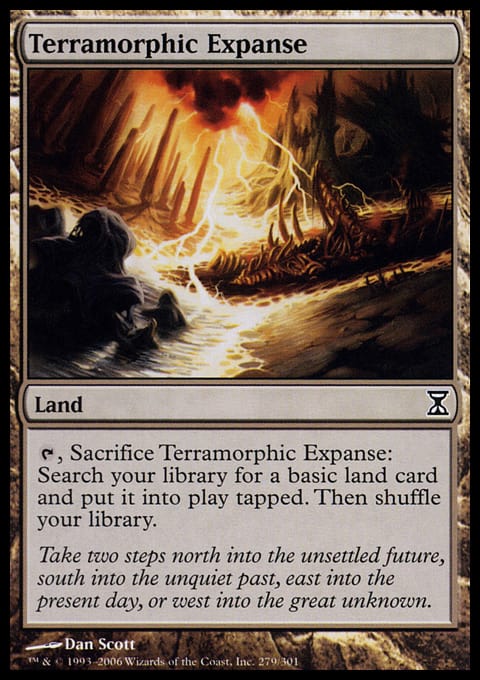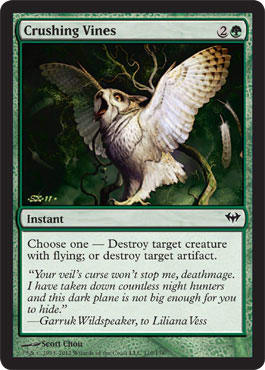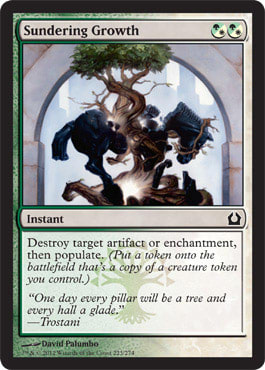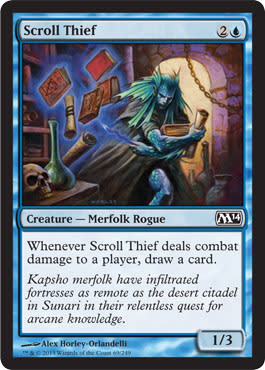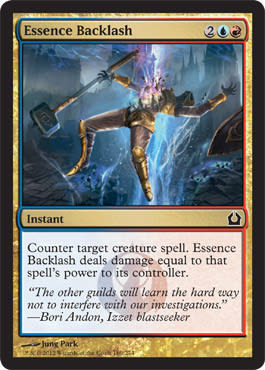Magic has been around for almost twenty years. During that time, Wizards of the Coast has released thousands and thousands of cards. Anybody who has played for any length of time, even six months, has acquired some of these cards. Today, I want to look at commons of various stripes and help to bring them into your deck-building once again.
One of my regular themes in the last more-than-ten years since I’ve been writing is to remind people of the useful cards they already have. Somewhere between cards that rule and cards that drool are the great unwashed mass of cards that just are. They are good, solid, and useful in the right situation. People often forget these cards.
Let’s look closer at your own personal card collection. Ever since I came back to grad school a second time, I have had a new appreciate for what is cheap. My monthly budget for entertainment is $150 (and that includes everything). Finding cards that I already own and using them for my deck-building is essential to making my budget work for me. I know that many of you may not have the money to clunk down on a lot of Magic cards week in and week out. Or perhaps you are a newer player with a smaller collection. Whatever the reason, lot’s peer into our commons and see what we can unearth.
One of the interesting things about the Magic economy is that a lot of Magic commons are free. At the Friday Night Magic at your local store, Draft cards are often left in a stack for anyone to pilfer as they have need. Take a look, and uncover some quality cards. I always check to see if there are any cards to snake out. You may have friends who buy cards by the booster box, and they often have twenty or thirty copies of cards they don’t even want, and they are happy to have you look through some of those boxes to relieve them of commons that aren’t highly valued. They might want to hold on to cards such as Terramorphic Expanse and the Guildgates, but you can often find removal, good utility creatures, and land-search for your decks.
If you don’t have a lot of cards, that’s fine. Most of things you need for your deck can be found in Standard or Extended sets in the common slots. Let’s look at what you can find in recent sets. We will only consider commons from Scars of Mirrodin and forward, plus Magic 2011 through Magic 2013.
Removal
The easiest and most powerful type of card you will find at commons is removal for permanents. Some of the best removal cards of all time are commons. Older removal commons include Orim's Thunder, Hull Breach, Dismantling Blow, Terminate, Rend Flesh, and many more. What cards have been printed recently?
To start with, some amazing removal options have been made in the last few years. Check out new awesome cards such as Murder while some old classics are reprinted, such as Lightning Bolt. Maybe you want to have some game against the horde of flyers you sometimes encounter in multiplayer. Aerial Predation is nice because of the 2-life bump you receive, but my preference is for Crushing Vines. It’s a 3-mana instant that can be used as a Shatter on a nasty artifact or on a flyer. It gives you two powerful abilities, and flexibility is crucial in casual games, where you often have no idea what the metagame will look like.
Flexibility is the reason I prefer a card such as Natural End to Naturalize. For 1 extra mana, you can gain some life from your instant removal. You never know when you need that little helping of life-gain. If you are going to want a Disenchant effect, perhaps you should consider Revoke Existence to exile an artifact or enchantment and thereby eliminate any chance of return.
In addition to flexibility, you also want card advantage. You can find that in commons regularly with your removal. Consider Ancient Grudge for a R/G deck or Ray of Revelation for G/W one. With token creatures in your deck, Trostani's Judgment or Sundering Growth can give you a double whammy of removal and a creature. In a similar way, Volt Charge and Spread the Sickness give you removal as well as proliferate for decks that can harness that power.
Do what you can to find cards such as Solemn Offering and Survey the Wreckage to add to your decks and give them a little more oomph.
Utility Creatures
Another great power often found in common slots are utility creatures. Just look at classics such as Llanowar Elves, Farhaven Elf, Ophidian, and Steel Wall for a variety of creatures that will power up many decks. Many versions of great critters like these are running around.
The last few sets have been rich with creatures such as these. Just consider mana makers such as the aforementioned Llanowar Elves, Arbor Elf, and Gatecreeper Vine. Scroll Thief does a nice Ophidian impression.
Don’t forget than there are many creatures that come into play and either do something nice or nasty. Manic Vandal will take out that great relic someone spent a lot of time making. For some other enters-the-battlefield triggers, look at Mist Raven, Archaeomancer, Elvish Visionary, Phyrexian Rager, and Gravedigger.
If you want reliable bodies for the early or midgame, you have people such as Seraph of Dawn and Delver of Secrets that are really appealing. Defensive bodies such as Angelic Wall and Ambush Viper also have nice appeal.
Any list of great multiplayer cards must consider Typhoid Rats or Suture Priest. We all know the sheer power of Squadron Hawk. One multiplayer essential from these sets is Liliana's Specter. Playing it not only gives you a modest flying body, but a ton of card advantage.
Utility Spells
I’ll admit some utility cards in commons are better than others. For example, if you want to draw a lot of cards, you need to upgrade that expansion symbol from black to at least silver. Tidings will give you a lot more cards in one go than any common spell this side of Deep Analysis. When looking at card-drawing, commons usually dig for one card. You are going to run into cards such as Ponder and Impulse. Those are backbone cards for many decks. Plus, you don’t have to shy away from cards such as Amass the Components and Foresee while you are preparing to dig with cards like Forbidden Alchemy, Gitaxian Probe, and Preordain. Also don’t ignore Sign in Blood for your black decks.
A lot of decks want the ability to make mana. Commons are where a lot of classics down through the years can be found, and the majority of the top land-searching cards have been in the common slot. Recent sets are no exception. Cultivate is a perfect example of power meeting price. Ranger's Path is another. While I know they are not technically utility “spells,” don’t forget valuable artifacts such as Horizon Spellbomb, Mycosynth Wellspring, and Traveler's Amulet.
Another useful utility card regularly found at the common spot is the great counter. From Counterspell on down, some great counters have been published at common. The ubiquitous Cancel is easily available. I adore Lost in the Mist as a later-game counter to surprise your foe. Fuel for the Cause gives you a counter plus a proliferate, and we have many creature counters in common in these sets that give you an extra zing: Geist Snatch, Bone to Ash, and Essence Backlash.
There are other great utility spells as well. While on the topic of good common artifacts as spells, don’t forget Nihil Spellbomb, a common so good it makes the cut in Eternal formats. There are ways to save your creatures (Apostle's Blessing, Rootborn Defenses), which can be used to keep your creatures alive through a massive attack or damage-based removal. You can make some nice tokenage with cards like Captain's Call and Eyes in the Skies. Classic discard spells from Duress on up are in these last few sets. We have Frantic Salvage as a nice recursion spell. We have tools to Flicker creatures for various abilities (Ghostly Flicker). Ruthless Invasion can basically stop your opponent from blocking this turn, enabling a nasty alpha strike to win the game. These are just a few utility spells out of many powerful ones.
Enchant-o-Matic and Lands, Too!
Let’s not forget our good enchantment friends. Some enchantments duplicate spells and creatures by acting as removal of sorts—Arrest and Pacifism are decent examples of creature removal. I like to stay away from enchantment-based creature removal because a Demystify or similar effect counters it, and the creature can keep going. An opponent can bounce it, flicker it, and so on. There are times when it’s better—for example, against a mono-black deck with a lot of reanimation. But that tends to be few and far between.
We have some great enchantments in these sets. Abundant Growth replaces itself when you play it and gives you any color of mana from the enchanted land. There are a few good milling enchantments here as well—Jace's Erasure and Curse of the Bloody Tome come to mind. Most common enchantments are Auras and tend to be bad math in any format, even Casual Land. Still, you can often find some winners.
Having a good mana base is important to winning. A few common lands are real pals because they are cheap and really useful. Terramorphic Expanse and Evolving Wilds both will fetch out a basic land as needed. Transguild Promenade makes any color of mana—even with the tempo loss, it’s very helpful in a deck with three or more colors. Finally, the Gates in Return to Ravnica and Gatecrash are very strong cards to enable any two-colored deck you might have. Common lands are quite valuable to any player; even one with a play set of original duals will play common land such as cycling lands, artifact lands, and the Karoo lands from the first Ravnica block. Pick up good common lands when you can—they are always going to have a home.
Of course, there are many commons from these sets that are worth playing that I did not mention. I didn’t want to give you all of the keys to the kingdom in one go! Plus, these are just recent sets. You can find a mega-mountain of great commons from older ones. So, go out there and find the right card for your next deck without spending a lot of money for the gold and red symbols.
See you next week,
Abe Sargent













